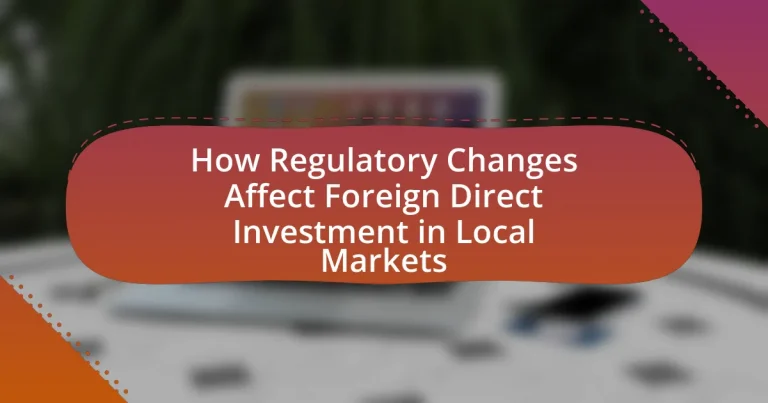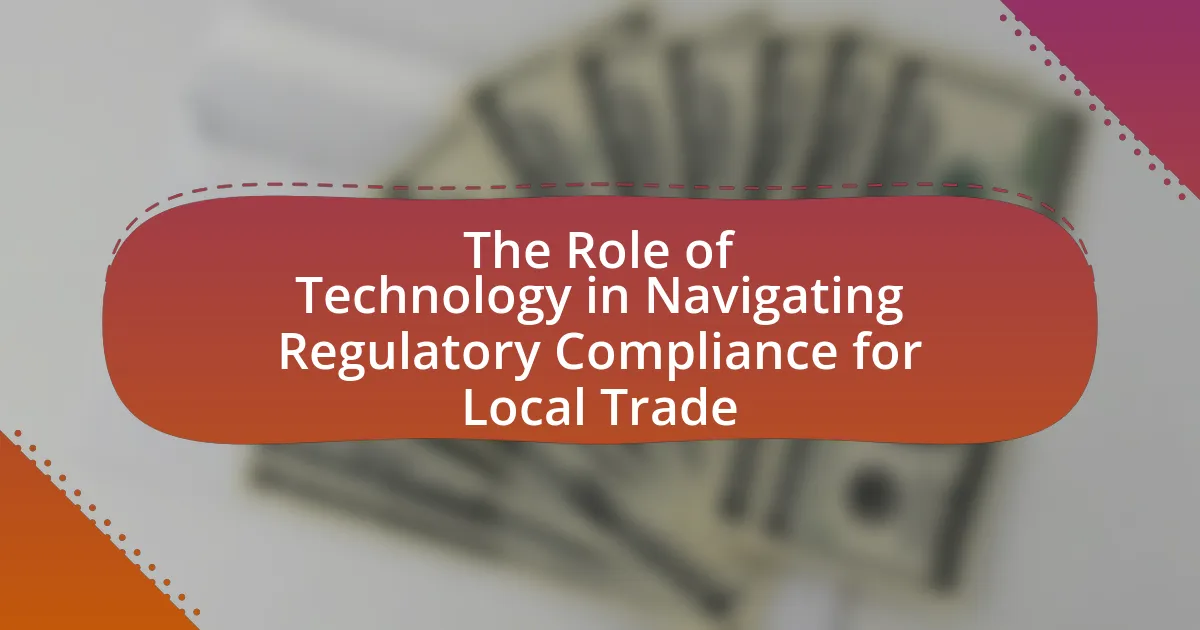The article examines how regulatory changes impact foreign direct investment (FDI) in local markets, highlighting the significance of regulatory frameworks in shaping the investment climate. It discusses various types of regulatory changes, including tax policies, trade regulations, and compliance requirements, and their effects on investor confidence and decision-making. The article also explores the risks associated with regulatory changes, the differing approaches of countries to regulation, and best practices for attracting FDI through effective regulatory environments. Additionally, it addresses the long-term consequences of regulatory changes on local economies, job creation, and the competitive landscape for businesses.

How do regulatory changes influence foreign direct investment in local markets?
Regulatory changes significantly influence foreign direct investment (FDI) in local markets by altering the business environment and investment climate. For instance, when a country implements favorable regulations, such as tax incentives or streamlined approval processes, it can attract more foreign investors seeking to capitalize on these benefits. Conversely, stringent regulations, such as high tariffs or complex compliance requirements, can deter FDI by increasing operational costs and risks for foreign companies. According to the World Bank’s “Doing Business” report, countries that improved their regulatory frameworks saw an increase in FDI inflows, demonstrating a direct correlation between regulatory quality and investment levels.
What types of regulatory changes impact foreign direct investment?
Regulatory changes that impact foreign direct investment (FDI) include changes in tax policies, trade regulations, investment restrictions, labor laws, and environmental regulations. For instance, a reduction in corporate tax rates can attract foreign investors by increasing potential returns, while stringent labor laws may deter investment due to higher operational costs. Additionally, changes in trade agreements can either facilitate or hinder market access for foreign companies, directly influencing their investment decisions. Historical examples include the North American Free Trade Agreement (NAFTA), which significantly increased FDI in North America by reducing trade barriers.
How do changes in tax policies affect foreign direct investment?
Changes in tax policies significantly influence foreign direct investment (FDI) by altering the cost-benefit analysis for multinational corporations. When a country reduces corporate tax rates or offers tax incentives, it becomes more attractive for foreign investors, leading to increased FDI inflows. For instance, the Tax Cuts and Jobs Act of 2017 in the United States lowered the corporate tax rate from 35% to 21%, resulting in a surge of FDI as companies sought to capitalize on the favorable tax environment. Conversely, increases in tax rates or the introduction of new taxes can deter investment, as seen in countries that have raised corporate taxes, leading to a decline in FDI. This relationship is supported by empirical studies, such as the OECD’s findings, which indicate that tax rates are a critical factor in investment decisions, with a 1% decrease in the effective tax rate potentially increasing FDI by 3% to 5%.
What role do trade regulations play in foreign direct investment decisions?
Trade regulations significantly influence foreign direct investment (FDI) decisions by establishing the legal framework within which international businesses operate. These regulations determine tariffs, quotas, and standards that can either facilitate or hinder market entry for foreign investors. For instance, countries with favorable trade agreements often attract more FDI, as seen in the North American Free Trade Agreement (NAFTA), which increased investment flows among the U.S., Canada, and Mexico by reducing trade barriers. Conversely, stringent regulations can deter investment; for example, high tariffs or complex compliance requirements may lead companies to seek more favorable environments elsewhere. Thus, the nature of trade regulations directly impacts the attractiveness of a market for foreign investors.
Why are regulatory environments important for foreign investors?
Regulatory environments are crucial for foreign investors because they establish the legal framework within which businesses operate, influencing investment decisions and risk assessments. A stable and transparent regulatory environment reduces uncertainty, making it easier for foreign investors to navigate local laws, understand tax obligations, and comply with labor regulations. For instance, according to the World Bank’s Ease of Doing Business report, countries with clear regulatory frameworks tend to attract more foreign direct investment, as investors seek environments that minimize legal risks and operational challenges.
How does regulatory stability influence investor confidence?
Regulatory stability significantly enhances investor confidence by providing a predictable and secure environment for investment decisions. When regulations remain consistent, investors can better assess risks and returns, leading to increased willingness to commit capital. For instance, a study by the World Bank found that countries with stable regulatory frameworks attract 30% more foreign direct investment compared to those with frequent changes in regulations. This stability reduces uncertainty, allowing investors to plan long-term strategies and fostering a climate of trust in the market.
What are the risks associated with regulatory changes for foreign investors?
Regulatory changes pose several risks for foreign investors, primarily including increased compliance costs, potential loss of investment, and market access restrictions. Increased compliance costs arise as foreign investors must adapt to new regulations, which can require significant financial and operational adjustments. The potential loss of investment occurs if regulatory changes lead to unfavorable conditions, such as expropriation or changes in tax policies that diminish profitability. Market access restrictions can limit foreign investors’ ability to operate or expand, particularly if new regulations impose quotas or licensing requirements. These risks are evidenced by historical instances, such as the abrupt changes in foreign investment laws in countries like Venezuela and Argentina, which led to substantial losses for foreign investors.
How do different countries approach regulatory changes affecting foreign direct investment?
Different countries approach regulatory changes affecting foreign direct investment (FDI) through varying frameworks that reflect their economic priorities and political environments. For instance, the United States often emphasizes national security in its regulatory changes, as seen in the Committee on Foreign Investment in the United States (CFIUS), which reviews foreign investments for potential risks. In contrast, countries like Singapore adopt a more open approach, actively encouraging FDI through incentives and streamlined processes, as evidenced by its consistently high rankings in the World Bank’s Ease of Doing Business Index. Additionally, the European Union implements regulatory frameworks that aim to balance investment protection with the need for transparency and competition, as demonstrated by the EU’s Investment Screening Regulation, which allows member states to review foreign investments for security concerns. These diverse approaches illustrate how regulatory changes are tailored to align with each country’s strategic interests and economic goals.
What are the best practices for countries to attract foreign direct investment through regulation?
Countries can attract foreign direct investment (FDI) through effective regulatory practices by ensuring a stable and transparent legal framework. A stable legal environment reduces risks for investors, as evidenced by the World Bank’s Ease of Doing Business Index, which shows that countries with clear regulations tend to attract more FDI. Additionally, simplifying administrative procedures and reducing bureaucratic hurdles can enhance the investment climate; for instance, Singapore’s streamlined processes have made it a top destination for FDI, ranking consistently high in global investment attractiveness. Furthermore, offering incentives such as tax breaks or investment grants can also encourage foreign investors, as seen in Ireland’s low corporate tax rate, which has successfully attracted numerous multinational corporations. Lastly, fostering a skilled workforce through education and training programs can make a country more appealing to foreign investors, as companies often seek locations with a capable labor pool.
How do emerging markets differ from developed markets in regulatory approaches?
Emerging markets differ from developed markets in regulatory approaches primarily through their flexibility and adaptability in regulations. Emerging markets often implement less stringent regulations to attract foreign direct investment, allowing for quicker adjustments to economic changes, while developed markets typically enforce more comprehensive and stable regulatory frameworks that prioritize investor protection and compliance. For instance, according to the World Bank’s Ease of Doing Business report, many emerging economies have streamlined business registration processes to encourage investment, contrasting with the more complex regulatory environments found in developed nations, which can include extensive compliance requirements and higher costs for businesses.

What are the consequences of regulatory changes on foreign direct investment?
Regulatory changes significantly impact foreign direct investment (FDI) by altering the investment climate, which can either attract or deter foreign investors. For instance, the introduction of favorable tax incentives or streamlined approval processes can enhance FDI inflows, as seen in countries like Ireland, which attracted substantial investments through its low corporate tax rate. Conversely, increased regulatory burdens, such as stricter compliance requirements or higher tariffs, can lead to a decline in FDI, as evidenced by the drop in investments in countries that have implemented protectionist policies. These consequences highlight the direct correlation between regulatory frameworks and the decisions made by foreign investors regarding market entry and capital allocation.
How can regulatory changes lead to shifts in investment flows?
Regulatory changes can lead to shifts in investment flows by altering the risk-reward profile for investors. When governments implement new regulations, such as tax incentives or stricter compliance requirements, they can either attract or deter foreign direct investment (FDI). For instance, the introduction of favorable tax regimes in countries like Ireland has historically attracted significant FDI, as companies seek to benefit from lower tax burdens. Conversely, increased regulatory burdens, such as stringent environmental laws, can lead to a decline in investment as firms reassess the viability of operating in that market. This dynamic is evidenced by the decline in FDI in countries that have enacted heavy regulatory frameworks, as seen in various reports from the World Bank, which highlight the correlation between regulatory environments and investment attractiveness.
What examples illustrate shifts in foreign direct investment due to regulation?
Regulatory changes can significantly shift foreign direct investment (FDI) patterns, as seen in the cases of the United States and China. In the U.S., the implementation of the Foreign Investment Risk Review Modernization Act (FIRRMA) in 2018 expanded the authority of the Committee on Foreign Investment in the United States (CFIUS) to scrutinize foreign investments, particularly in technology sectors, leading to a decline in Chinese investments in American tech firms. Conversely, China’s introduction of the Foreign Investment Law in 2020 aimed to attract foreign capital by providing better protection for intellectual property and reducing market access barriers, resulting in increased FDI inflows from various countries. These examples illustrate how regulatory frameworks directly influence the direction and volume of foreign investments.
How do regulatory changes affect the competitive landscape for local businesses?
Regulatory changes significantly impact the competitive landscape for local businesses by altering operational costs, market entry barriers, and compliance requirements. For instance, when regulations become more stringent, local businesses may face increased costs related to compliance, which can disadvantage smaller firms that lack resources compared to larger competitors. Conversely, deregulation can lower entry barriers, allowing new entrants to compete more effectively, thereby intensifying competition. A study by the World Bank indicates that countries with streamlined regulatory environments attract more foreign direct investment, which can further disrupt local markets by introducing new competitors and innovative practices.
What are the long-term effects of regulatory changes on local economies?
Long-term effects of regulatory changes on local economies include shifts in investment patterns, employment rates, and business growth. Regulatory changes can either attract or deter foreign direct investment (FDI), which significantly impacts local economic development. For instance, a study by the World Bank found that countries with stable and transparent regulatory environments tend to attract more FDI, leading to job creation and increased local business activity. Conversely, stringent regulations can lead to reduced investment, stunted economic growth, and higher unemployment rates. Historical examples, such as the deregulation of the telecommunications sector in the United States, demonstrate that easing regulations can lead to increased competition, innovation, and economic expansion in local markets.
How do regulatory changes impact job creation in local markets?
Regulatory changes significantly impact job creation in local markets by altering the business environment and influencing investment decisions. For instance, when regulations are relaxed, businesses often experience lower operational costs and increased profitability, which can lead to expansion and the creation of new jobs. A study by the World Bank found that countries that streamlined business regulations saw a 30% increase in new firm registrations, directly correlating with job growth in those regions. Conversely, stringent regulations can deter investment, leading to job stagnation or loss, as companies may relocate to more favorable environments. Thus, the nature of regulatory changes plays a crucial role in shaping employment dynamics within local markets.
What is the relationship between regulatory changes and economic growth?
Regulatory changes significantly influence economic growth by altering the business environment and investment climate. When regulations are streamlined or improved, they can enhance market efficiency, attract foreign direct investment, and stimulate innovation. For instance, a study by the World Bank found that countries implementing regulatory reforms, such as reducing the time to start a business, experienced an increase in GDP growth rates. Conversely, overly stringent regulations can hinder economic activity by increasing compliance costs and discouraging investment. Therefore, the relationship between regulatory changes and economic growth is characterized by the impact of regulatory frameworks on business operations and investment decisions.
How do investors adapt to regulatory changes in local markets?
Investors adapt to regulatory changes in local markets by conducting thorough assessments of the new regulations and adjusting their investment strategies accordingly. This often involves reallocating resources, diversifying portfolios, or altering operational practices to ensure compliance and mitigate risks. For instance, a study by the World Bank indicates that foreign direct investment (FDI) flows can be significantly influenced by regulatory environments, with investors often seeking markets with stable and predictable regulations. Additionally, investors may engage in dialogue with local authorities to better understand the implications of regulatory changes, thereby enhancing their ability to navigate the evolving landscape effectively.
What strategies do foreign investors employ to mitigate regulatory risks?
Foreign investors employ several strategies to mitigate regulatory risks, including thorough due diligence, engaging local legal expertise, and diversifying investments across multiple jurisdictions. Conducting comprehensive due diligence allows investors to understand the regulatory landscape and identify potential risks before entering a market. Engaging local legal experts provides insights into compliance requirements and helps navigate complex regulations effectively. Additionally, diversifying investments across different countries reduces exposure to regulatory changes in any single market, thereby spreading risk. These strategies are supported by research indicating that informed investment decisions and local partnerships significantly enhance compliance and reduce the likelihood of regulatory penalties.
How can foreign investors engage with local regulators effectively?
Foreign investors can engage with local regulators effectively by establishing clear communication channels and fostering relationships built on trust. This involves actively participating in public consultations, attending regulatory meetings, and seeking feedback on proposed regulations. For instance, the World Bank emphasizes the importance of dialogue between investors and regulators to enhance transparency and predictability in the investment climate. Additionally, foreign investors should familiarize themselves with local laws and regulations to demonstrate compliance and commitment to the local market, which can further facilitate constructive interactions with regulatory bodies.

What strategies can local markets implement to navigate regulatory changes affecting foreign direct investment?
Local markets can implement several strategies to navigate regulatory changes affecting foreign direct investment (FDI). First, they can establish strong communication channels with regulatory bodies to stay informed about upcoming changes and provide feedback on proposed regulations. This proactive engagement allows local markets to influence policy decisions and adapt more swiftly to new requirements.
Second, local markets can invest in compliance training for businesses to ensure they understand and adhere to new regulations, reducing the risk of penalties and fostering a more stable investment environment. For instance, according to a report by the World Bank, countries that prioritize regulatory transparency and compliance training see a 20% increase in FDI inflows.
Third, forming public-private partnerships can help local markets pool resources and share knowledge to better navigate complex regulatory landscapes. These collaborations can lead to innovative solutions that align with regulatory expectations while promoting investment.
Lastly, local markets can leverage technology to streamline compliance processes, making it easier for foreign investors to meet regulatory requirements. The use of digital platforms for reporting and compliance has been shown to reduce administrative burdens and enhance investor confidence, as evidenced by studies indicating that countries with advanced digital infrastructure attract 30% more FDI.
How can local governments create a favorable regulatory environment for foreign investors?
Local governments can create a favorable regulatory environment for foreign investors by implementing transparent policies, reducing bureaucratic hurdles, and providing incentives such as tax breaks or grants. Transparency in regulations fosters trust and predictability, which are crucial for foreign investors. For instance, countries like Singapore have successfully attracted foreign direct investment (FDI) by streamlining their regulatory processes and ensuring clear communication of laws and policies. Additionally, reducing bureaucratic hurdles can significantly decrease the time and cost associated with starting and operating a business, as evidenced by the World Bank’s Ease of Doing Business Index, where countries with simpler regulations rank higher in attracting FDI. Providing financial incentives, such as tax holidays or subsidies, can further enhance the attractiveness of a location for foreign investors, as seen in various special economic zones around the world that have successfully drawn significant foreign investment.
What policies can be introduced to enhance regulatory transparency?
To enhance regulatory transparency, governments can implement policies such as mandatory public consultations, regular reporting requirements, and the establishment of independent oversight bodies. Mandatory public consultations ensure that stakeholders, including businesses and citizens, have the opportunity to provide input on proposed regulations, fostering a more inclusive decision-making process. Regular reporting requirements compel regulatory agencies to disclose their activities, decisions, and the rationale behind them, which can improve accountability. The establishment of independent oversight bodies can provide an additional layer of scrutiny, ensuring that regulations are enforced fairly and consistently. These policies have been shown to improve trust in regulatory frameworks, as evidenced by studies indicating that increased transparency correlates with higher levels of foreign direct investment, as investors seek stable and predictable regulatory environments.
How can local markets balance regulation and investment attraction?
Local markets can balance regulation and investment attraction by implementing transparent and adaptive regulatory frameworks that foster business confidence while ensuring compliance with necessary standards. For instance, countries like Singapore have successfully attracted foreign direct investment (FDI) by creating a regulatory environment that is both business-friendly and protective of local interests, evidenced by its consistent ranking as one of the top destinations for FDI according to the United Nations Conference on Trade and Development (UNCTAD). By engaging stakeholders in the regulatory process and regularly updating policies to reflect market conditions, local markets can create a dynamic environment that encourages investment while maintaining essential regulatory oversight.
What role do public-private partnerships play in regulatory reform?
Public-private partnerships (PPPs) play a crucial role in regulatory reform by facilitating collaboration between government entities and private sector organizations to create more efficient and effective regulatory frameworks. These partnerships leverage the strengths of both sectors, where the public sector provides regulatory oversight and public interest objectives, while the private sector contributes innovation, expertise, and resources. For instance, studies have shown that PPPs can lead to streamlined processes and reduced compliance costs, ultimately enhancing the business environment for foreign direct investment. A report by the World Bank highlights that countries with active PPP frameworks often experience improved regulatory quality, which attracts more foreign investment by providing a stable and predictable regulatory landscape.
How can collaboration between government and businesses improve regulatory outcomes?
Collaboration between government and businesses can improve regulatory outcomes by fostering a more informed and responsive regulatory environment. When governments engage with businesses, they gain insights into industry challenges and operational realities, which can lead to regulations that are practical and effective. For instance, the U.S. Small Business Administration’s Office of Advocacy has shown that regulatory feedback from businesses can lead to significant changes in policies, resulting in reduced compliance costs and enhanced economic growth. This collaborative approach not only streamlines regulatory processes but also encourages innovation and investment, as businesses feel more secure in their operational landscape.
What successful case studies exist of public-private partnerships in regulatory reform?
Successful case studies of public-private partnerships in regulatory reform include the collaboration between the government of Singapore and private sector entities to streamline business regulations, resulting in a significant increase in foreign direct investment (FDI). This partnership led to the establishment of the Regulatory Authority of Singapore, which simplified the licensing process and reduced the time required to start a business from 30 days to just a few hours. Additionally, the partnership between the government of the United Kingdom and the private sector in the Better Regulation Executive initiative aimed to reduce regulatory burdens on businesses, which contributed to a 20% reduction in regulatory costs for small and medium enterprises. These examples demonstrate how effective public-private partnerships can lead to successful regulatory reforms that enhance the investment climate and attract FDI.
What practical steps can foreign investors take to navigate regulatory changes?
Foreign investors can navigate regulatory changes by conducting thorough due diligence and staying informed about local laws. This involves regularly reviewing updates from government agencies, engaging with local legal experts, and participating in industry associations that provide insights on regulatory developments. For instance, the World Bank’s “Doing Business” report offers valuable data on regulatory environments across countries, helping investors assess risks and opportunities. Additionally, establishing strong relationships with local partners can facilitate better understanding and adaptation to regulatory shifts, ensuring compliance and strategic alignment with local market conditions.
How can foreign investors stay informed about regulatory developments?
Foreign investors can stay informed about regulatory developments by subscribing to official government publications and industry newsletters. These sources provide timely updates on changes in laws and regulations that impact foreign direct investment. Additionally, engaging with local legal and financial advisors ensures that investors receive tailored insights and interpretations of regulatory changes. Research indicates that 70% of foreign investors rely on local experts to navigate complex regulatory environments, highlighting the importance of professional guidance in staying compliant and informed.
What resources are available for foreign investors to understand local regulations?
Foreign investors can utilize government websites, legal firms, and investment promotion agencies to understand local regulations. Government websites often provide comprehensive guidelines and legal frameworks relevant to foreign investment, including necessary permits and compliance requirements. Legal firms specializing in international business law offer tailored advice and insights into local regulations, ensuring investors navigate the legal landscape effectively. Additionally, investment promotion agencies serve as valuable resources, offering information on regulatory changes, investment incentives, and support services for foreign investors. These resources collectively facilitate a clearer understanding of local regulations, enabling informed investment decisions.




